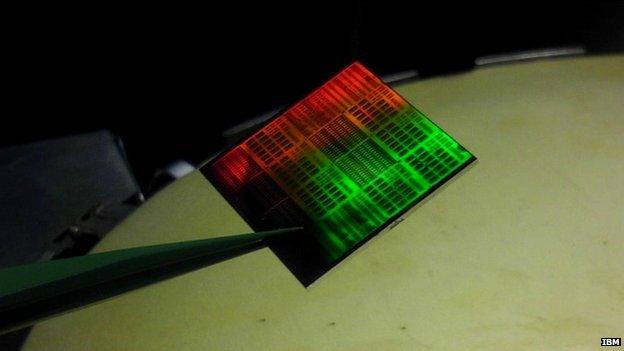Graphene circuit's wireless promise
- Published

A global research effort is aimed at harnessing graphene's extraordinary properties
The promise of faster, cheaper and more efficient wireless devices has moved a step closer.
Researchers at IBM have demonstrated the most advanced integrated circuit made of wafer-scale graphene - often touted as a "wonder material" that could revolutionise electronics.
Graphene circuits could allow mobile devices to transmit data loads in a much speedier manner.
Details have been published in the journal Nature Communications.
Produced for the first time in 2004 by Andre Geim and Konstantin Novoselov at the University of Manchester, graphene consists of a single layer of carbon atoms packed in a honeycomb structure.
The material is the subject of global research efforts aimed at harnessing the extraordinary electrical, optical, mechanical and thermal properties that potentially make it a cheaper and more energy efficient choice than silicon in electronics.
"This is the first time that someone has shown graphene devices and circuits to perform modern wireless communication functions comparable to silicon technology," said Supratik Guha, director of physical sciences at IBM Research.
The growth of big data applications has placed increased importance on the development of improved mobile devices that can transmit and receive increasingly large amounts of information more efficiently. IBM says graphene is particularly suited for wireless communications.
True integrated circuits based on graphene have been difficult to build because the material's nano-scale dimensions have meant that it could be easily damaged during fabrication.
In 2011, IBM built a proof-of-concept - an analogue graphene circuit with a broadband frequency mixer.
But the performance of the graphene transistor was relatively poor owing to a lack of refinement in the manufacturing process. Since then, the researchers have been working to improve the prototypes.
Scientists have now developed a manufacturing method that fully preserves the transistor quality. Using this approach, they were able to demonstrate the most sophisticated graphene-based integrated circuit to date.
To showcase its true functionality, the researchers were able to use it to transmit a text message displaying the letters "I-B-M".
The circuit's performance was 10,000 times better than previously reported efforts for graphene integrated circuits.
The researchers describe it as a step towards true graphene technology.
Paul.Rincon-INTERNET@bbc.co.uk and follow me on Twitter, external